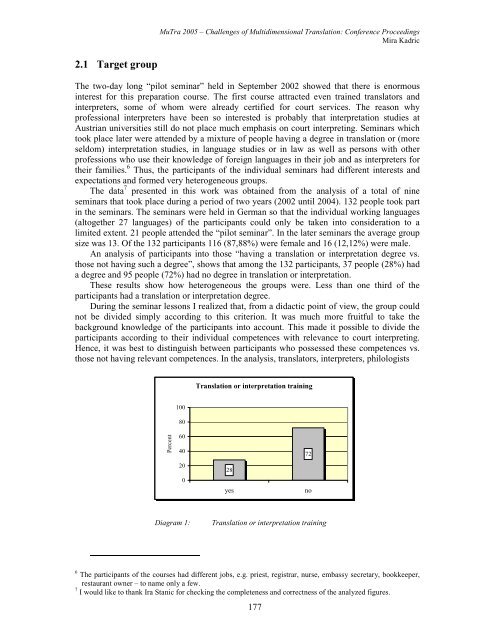Proceedings - Translation Concepts
Proceedings - Translation Concepts
Proceedings - Translation Concepts
Create successful ePaper yourself
Turn your PDF publications into a flip-book with our unique Google optimized e-Paper software.
MuTra 2005 – Challenges of Multidimensional <strong>Translation</strong>: Conference <strong>Proceedings</strong><br />
Mira Kadric<br />
2.1 Target group<br />
The two-day long “pilot seminar” held in September 2002 showed that there is enormous<br />
interest for this preparation course. The first course attracted even trained translators and<br />
interpreters, some of whom were already certified for court services. The reason why<br />
professional interpreters have been so interested is probably that interpretation studies at<br />
Austrian universities still do not place much emphasis on court interpreting. Seminars which<br />
took place later were attended by a mixture of people having a degree in translation or (more<br />
seldom) interpretation studies, in language studies or in law as well as persons with other<br />
professions who use their knowledge of foreign languages in their job and as interpreters for<br />
their families. 6 Thus, the participants of the individual seminars had different interests and<br />
expectations and formed very heterogeneous groups.<br />
The data 7 presented in this work was obtained from the analysis of a total of nine<br />
seminars that took place during a period of two years (2002 until 2004). 132 people took part<br />
in the seminars. The seminars were held in German so that the individual working languages<br />
(altogether 27 languages) of the participants could only be taken into consideration to a<br />
limited extent. 21 people attended the “pilot seminar”. In the later seminars the average group<br />
size was 13. Of the 132 participants 116 (87,88%) were female and 16 (12,12%) were male.<br />
An analysis of participants into those “having a translation or interpretation degree vs.<br />
those not having such a degree”, shows that among the 132 participants, 37 people (28%) had<br />
a degree and 95 people (72%) had no degree in translation or interpretation.<br />
These results show how heterogeneous the groups were. Less than one third of the<br />
participants had a translation or interpretation degree.<br />
During the seminar lessons I realized that, from a didactic point of view, the group could<br />
not be divided simply according to this criterion. It was much more fruitful to take the<br />
background knowledge of the participants into account. This made it possible to divide the<br />
participants according to their individual competences with relevance to court interpreting.<br />
Hence, it was best to distinguish between participants who possessed these competences vs.<br />
those not having relevant competences. In the analysis, translators, interpreters, philologists<br />
<strong>Translation</strong> or interpretation training<br />
100<br />
80<br />
Percent<br />
60<br />
40<br />
20<br />
0<br />
28<br />
yes<br />
72<br />
no<br />
Diagram 1:<br />
<strong>Translation</strong> or interpretation training<br />
6 The participants of the courses had different jobs, e.g. priest, registrar, nurse, embassy secretary, bookkeeper,<br />
restaurant owner – to name only a few.<br />
7 I would like to thank Ira Stanic for checking the completeness and correctness of the analyzed figures.<br />
177
















